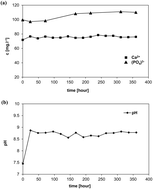Is non-buffered DMEM solution a suitable medium for in vitro bioactivity tests?
Abstract
Several laboratories had tested bioactivity of the materials in commercially available solution DMEM (Dulbecco’s Modified Eagle’s Medium) that is normally used for cultivation of cell cultures. The objective of this work was to find out whether it is possible to replace TRIS-buffered SBF currently used for bioactivity tests with the non-buffered DMEM solution. To understand the role of the organic part of the DMEM solution in the process of crystallization, we have prepared non-buffered solution simulating only its inorganic part (identified as I-solution). It was found that under static-dynamic test conditions calcite (CaCO3) and the amorphous phase of calcium phosphate (ACP) formed on the surface of the glass-ceramic (45S5 bioactive glass based) scaffold exposed to both solutions. Additionally, halite (NaCl) formed at the beginning of exposure to DMEM. Hydroxyapatite phase was not detected on the surface in either non-buffered solution. Organic components contained in the DMEM solution failed to prevent formation of crystalline phases. The present results indicate that it is not recommendable to use DMEM for bioactivity tests of glass-ceramic materials due to its low concentration of Ca2+ ions, high concentration of HCO3− ions and the necessity to maintain sterile environment during the test.


 Please wait while we load your content...
Please wait while we load your content...